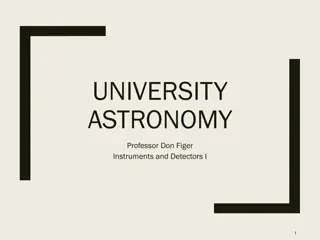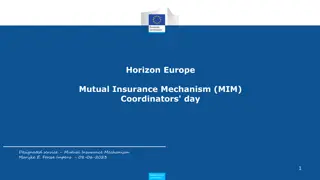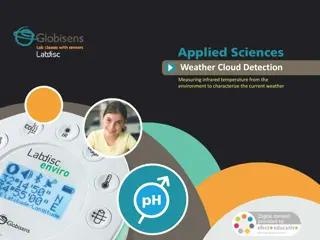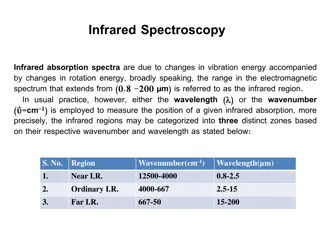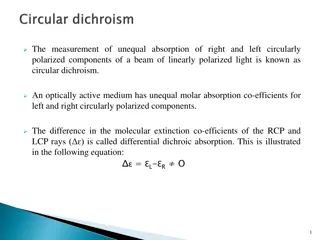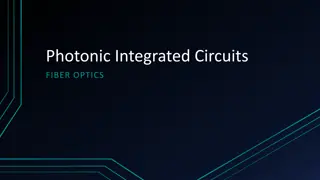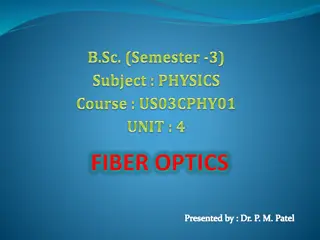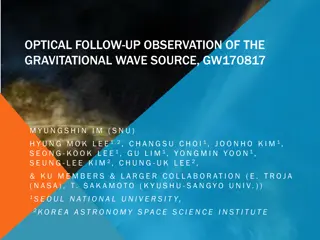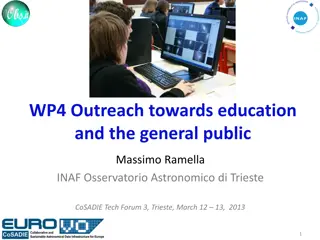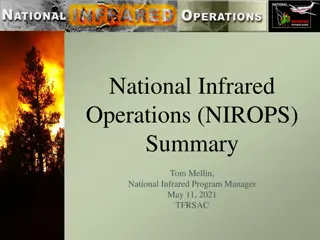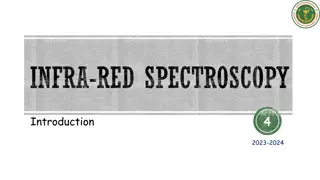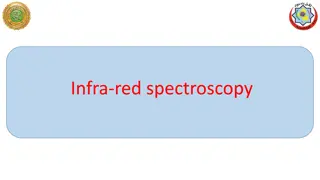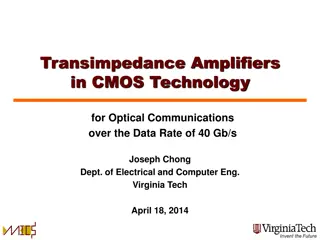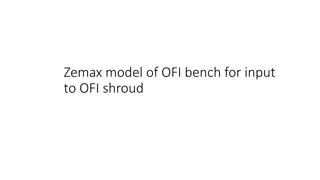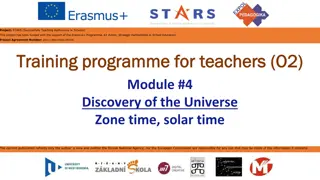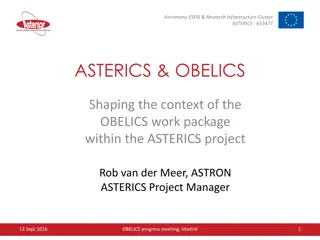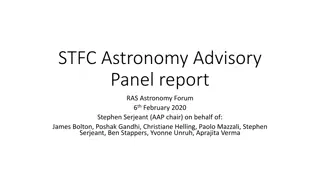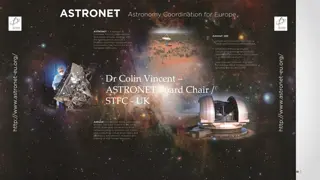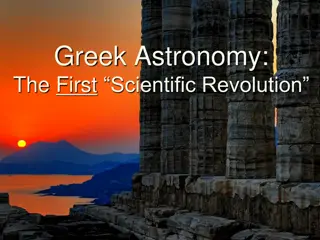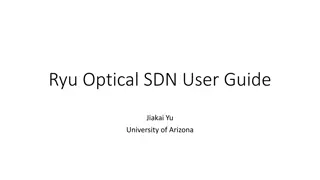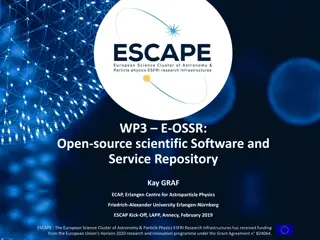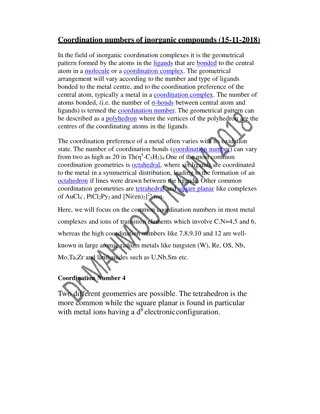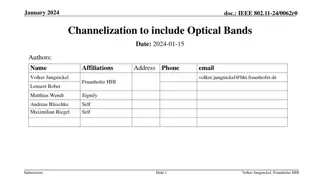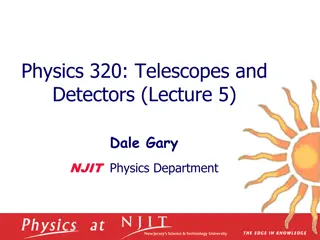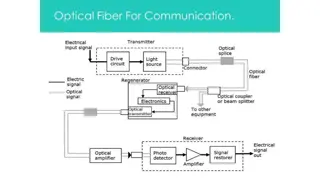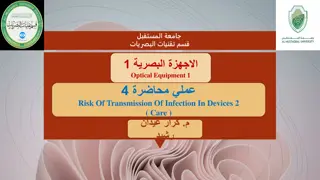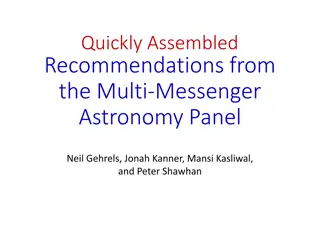Optical Infrared Coordination Network for Astronomy (FP7 2013-2016), HORIZON (2017-2020)
This network consolidates funding and support for Europe's optical and infrared astronomy facilities, aiming to enhance infrastructure, train new astronomers, and develop cutting-edge technologies. It emphasizes collaboration among national and international agencies, optimizing access to mid-size telescopes and promoting joint actions for research quality improvement. The Time Allocation Committee plays a crucial role in facilitating telescope usage, ensuring diverse user representation and project allocation fairness. Different observation modes like monitoring, service, and robotic observations cater to various scientific needs, promoting research efficiency. Successful proposers receive travel funds for observing time utilization, with provisions for scientific justification and multi-observer support.
Download Presentation

Please find below an Image/Link to download the presentation.
The content on the website is provided AS IS for your information and personal use only. It may not be sold, licensed, or shared on other websites without obtaining consent from the author. Download presentation by click this link. If you encounter any issues during the download, it is possible that the publisher has removed the file from their server.
E N D
Presentation Transcript
Optical Infrared Coordination Network for Astronomy (FP7 2013 2016), HORIZON (2017-2020) brings together all the national and international agencies and organisations, which fund, support, develop and operate Europe s facilities for optical and infrared night-time astronomy. provides a framework allowing joint actions to improve the quality of Europe s infrastructures, to train new astronomers, especially those from Central Europe, in modern new research methods, to develop innovative technologies to enhance research quality. to provide access to mid-size optical telescopes: 2 calls per year-February and August
TIME ALLOCATION COMMITTEE Member information Frank Grundahl, Aarhus University, Denmark Beth Biller, Institute for Astronomy, ROE Edinburgh Guilaine Lagache, Laboratoire d'Astrophysique de Marseille, Aix-Marseille Universit , France Ren Duffard, Instituto de Astrof sica de Andaluc a, Spain Ennio Poretti, Osservatorio Astronomica di Brera, Italy [Chair] Geza Kovacs, Konkoly Observatory, Hungary Jochen Heidt, LSW, Heidelberg, Germany
The group leader and the majority of the users must work at institutions which are outside the country/ies which operate the telescope'. The interpretation of 'majority' is 50% + 1 user, and the user group leader is a member of the user group. Note that projects led by, or dominated by, non-EU persons are no longer prohibited but such projects are limited to 20% of the total allocations. In practice this means only a small number of such projects can be allocated and so such proposals must be exceptionally well justified. If in doubt, contact the OPTICON Project Scientist (details below) for clarification.
OBSERVATIONS Monitoring: Observations which require a regular cadence (eg SN decay, giant planet weather, comet activity with heliocentric distance) but which are not highly date/time specific. May be executed in servicemode to minimize PI travel. Service Mode: Observations which are carried out by a local astronomer as part of a classically scheduled operations without flexibility for specific observing constraints. Also known as Delegated visitor mode . The PI is not expected to provide an observer. Robotic: Automated telescope or network of telescopes using software to schedule and execute observations according to observatory schedule, weather and priority algorithms without direct human intervention on a nightly basis. Essentially automated queue scheduling without real-time human discretion. Requests for multiple telescopes for the same scientific project must be included in a single proposal form.
Successful proposers will receive travel funds as necessary for them to take up the observing time. This will normally be for a single observer. If travel support for more than one observer is required for clearly demonstrated scientific reasons it will be necessary to get confirmation from the Project Scientist (details below). Please also see the section on Trans-National Access on our Rules for Travel page. The proposal software, an OPTICON variant of the NORTHSTAR system already in use at several observatories, is available at the following url: http://proposal.astro- opticon.org. You are required to register for account (only minimal information is required) and you can then create, share and complete your proposal on-line.
Isaac Newton Group of Telescopes, La Palma, Roques de los Muchachos Observatory: 4.2 m William Gershel Telescope ; Monitoring mode yes ISIS: 3000-10000 ; 600 R 12700; 0.2 /px; 1.62 /px; slit 4 ; + imaging polarimetry and spectropolarimetry LIRIS: 9000-24000 ; 1000 R 3000 slit 4 + imaging polarimetry and spectropolarimetry ACAM: 3500 - 9400 R ~ 400 slit 6 AF2/WYFFOS: 3500 - 10000 100 < R < 3000 (reflection mode) R = 9500 (echelle mode) IMAGING MODE ACAM: FOV is 8 arcmin (0.25 arcsec/pixel). A set of broad-band filters is available by default (SDSS u g r i z) but almost any of narrow filters available can be mounted in ACAM LIRIS: Z,J,H,K +8 narrow-band; 0.25arcsec/px, FOV=4.5 arcmin 2.5 m Isaac Newton Telescope; Monitoring mode yes IDS: 3000-10000 ; 700 R 10000; slit 3.3 IMAGING MODE WFC: 0.33 arcsec/px; FOV=33 arcmin; set of broad-band and narrow-band filters
3.58 The Telescopio Nazionale Galileo (TNG) Roque de Los Muchachos Observatory, La Palma GIANO : IR high resolution echelle spectrograph R~50000; 0.95 m -2.45 m HARPS-N : high resolution echelle spectrograph for radial velocities measurements; 383 693 nm, with a spectral resolution R=115000 DOLORES : low resolution spectrograph and camera, R=~500 and R=~6000 IMAGING MODE through broad and narrow band filters , the scale is 0.252 arcsec/px , FOV= 8.6 x 8.6 arcmin. NICS: near infrared low resolution spectroscopy 0.9 -2.5 m R=50-500, medium-resolution max R=2500 Imaging mode: FOV=4.2x4.2 arcmin, imagning, imaging polarimetry, spectropolarimetry
3.6 m Canada-France-Hawaii Telescope, Mounakea, Hawaii ESPaDOnS: Echelle Spectro-Polarimetric Device for the Observation of Stars at CFHT; Each exposure covers 40 orders from 3700 to 10500 , spectroscopy R=68,000; spectroscopy 'star only' (no sky), R=80,000, spectropolarimetry, linear or circular polarization, R=68,000 SITELLE: optical Fourier spectrometer, FOV (350 to 900 nm) 11 11 , with a variable spectral resolution, from R=2 to R>104 (for low to high spectroscopic studies) MegaCam: wide-field imager, 36 2048 x 4612 pixel CCDs (a total of 340 megapixels), a full 1 x 1 FOV of 0.187 /px to (average seeing=0.7), SDSS u, g, r, i, z, u , g , r , i , z WIRCam: the near infrared mosaic imager, a mosaic of four detectors, each containing 2048 x 2048 pixels, with a sampling of 0.3 arc second per pixel. Broad-band Y, Z, H, Ks to 2.2 m
The Australian Astronomical Observatory Keck 10m Gemini 8.1m Magellan 6.5m AAT 3.9m Blanco 4.0m UKSchmidt 1.2m SkyMapper 1.2 m Faulkes South 2m ANU 2.3m https://www.aao.gov.au/science/observing/apply-for- observing-time
2.6m Nordic Optical Telescope La Palma; Monitoring mode - yes ALFOCS: a FOV= 6.4x6.4 , 0.21 /pixel in imaging mode UV low/medium resolution spectroscopy , multi-object spectroscopy, fast spectroscopy, polarimetry, : Bessell UBVRI, SDSS u'g'r'i'z' NOTcam: 0.8 - 2.5 m, wild-field imaging, high-resolution imaging (0 .078/px), low- resolution spectroscopy, R = 2500 (Y,J,H,K); medium-resolution spectroscopy, R = 5500 (J,H,K) FIES: 0.370-0.830 m, a cross-dispersed high-resolution echelle spectrograph with a maximum spectral resolution of R = 67000 MOSCA : a direct CCD camera mounted in the Cassegrain focus, FOV=7.7' x 7.7 , 0.217"/pixel on sky (2x2 binning) FILTERS: Bessell UBVRI, SDSS u'g'r'i'z';(90mm) Str mgren uvby, H-beta wide, narrow
2.0m The Liverpool Telescope (Robotic), La Palma IO:O: Optical Wide Field Camera, FOV 10x10 ; 0.15 /pxl; Filters Bessel, SDSS imaging IO:I: Near Infrared imaging component IO:O, currently offline RINGO3: 3-band optical polarimeter LOTUS: (LOw-cosT Ultraviolet Spectrograph) a low resolution optical-near UV spectrograph, 3200 6300 , 4.7 /pxl. The slit has "narrow" (2.5 arcsec x 95 arcsec) and "wide" (5 arcsec x 25 arcsec) regions SPRAT: (SPectrograph for the Rapid Acquisition of Transients) is a low resolution, high throughput spectrograph, R=350 (18 ), slit - 1.8arcsec, FOV in imaging mode 7.5 x 1.9 , 4000 8000 .
CAHA: The German-Spanish Astronomical Center at Calar Alto is located in the Sierra de Los Filabres , Span 3.5m Telescope, Monitoring mode Yes with CARMENES and PMAS CARMENES: (Calar Alto High-Resolution search for M dwarfs with Exoearths with Near-infrared and optical chelle Spectrographs): two separated spectrographs 0.52 - 0.96 m and 0.96 - 1.71 m with R = 80,000-100,000 each of spectrograph performs high-accuracy radial-velocity measurements ( 1 m s-1) with long-term stability MOSCA: the focal reducer, 0.33 /pxl, FOV of 11x11 arcmin. Various analyzers are or will eventually be available: filters, grisms, FPI, (polarimetry?) PMAS: Integral Field Spectroscopy with fiber-coupled lens array 0.360-0.940 m TWIN: Spectrograph provides two channels intermediate spectral resolution (R=3000-14000) in the wavelength range from 3200 to 11000
CAHA 2.2m Telescope, Monitoring mode yes BUSCA: a CCD camera system 12'x12' which allows simultaneous direct imaging of the same sky area in four colors < 430nm, 430nm < lambda < 530nm, 530nm < lambda < 700nm and lambda > 700nm.Additional filters are provided to define standard wavelength bands. Currently the Str mgren filter set is available. (it is interesting but needs time to understand!) CAF : provides high resolution echelle spectra over 3900-9600 http://www.caha.es/CAHA/Instruments/CAFE/ CAFOS a focal-reducer designed to work with a CCD detector Imaging mode: standard filters (Johnson, Cousins, Gunn) and (on request) a large set of interference filters (l / Dl = 30 ... 100) are available. Spectroscopy: three grism sets (400 /mm, 200 /mm, 100 /mm) . A long slit of variable width (b=50 ... 1000 m, corresponding to 0.6" ... 12") Polarimetry: linear polarization only: a Wollaston prism with an effective beam separation of ~20 + a rotatable l/2 plate
Observatoire de HAUT-Provence 1.93m Telescope Monitoring mode - yes SOFI: a cross-dispersed chelle spectrograph, 3872-6943 ; two circular apertures (3 arc-sec wide) for the target and the sky spectrum or for a simultaneous lamp exposure, R=75000 or R=40000 1.20m Telescope Monitoring mode no CCD camera: 2048x2048 pixels, E2V, CCD42-40. Quantique maximum >95% 500 - 650 nm); 13.5 m pixels with a scale of 0.385". FOV is 13.1' 13.1'. Broad band filters: U , Cousins B, V, R ; Gunn u, v, g, r, i, z . MPG/ESO La Silla 2.2m Telescope Monitoring mode on special arrangement FEROS: high-resolution chelle spectrograph; R~48000, ~3500 to ~9200 . WFI: The Wide Field Imager, a focal reducer-type camera at the Cassegrain focus. FOV- 34'x33'; Scale - 0.238''. Sensitivity from 350 nm to the near IR, with more than 40 filters simultaneously available
Tenerife Carlos Sanchez 1.52 m Telescope, Monitoring mode - yes, remote mode - yes CAIN-III: Infrared camera, a mosaic of 256 x 256 (NICMOS 3 technology), sensitive 1.0 2.5 m; pixel s physical size is 40 m, corresponding to scales in the focal plane of 1 arcsec/pixel and 0.39 arcsec/pixel for the wide and narrow field configurations, respectively; FOV is 4.2 4.2 arcmin (wide) and 1.7 1.7 arcmin (narrow), J, H, K bands with the lim magn~ 17-18 FASTCAM: camera for lucky images technique Helmos Observatory, Greece 2.2m Aristarchos Telescope, Monitoring mode possible but difficult CCD Cameras: FOV 4.4 x4.4 , 5.5 x5.5 , 10 x10 with a scales of 0.28 ,0.19 , 0.17 Filters BVRI, emission line filters, comet filters and continuum B and R
Las Cambres Observatory network of fully robotic telescopes 1.0 m Network Set of 1-m telescopes at the different sites. Filters UBVRand SDSS; ccd SBG and Sinistro https://lco.global/observatory/sites/ The OPTICON contract is for time on the LCO 1m network. Time on the 2m network may be requested but will be subject to a further internal negotiation with LCO if such projects are approved by the OPTICON TAC.
La Silla 0.6m REM (Rapid Eye Mount) robotic, fast reacting telescope located in the La Silla premises ROSS2: a simultaneous multi-channel imaging camera delivering four different bands onto four quadrants of the same 2kx2k CCD detector, FOV 9x9 ; scale 0.58 /px; split by plate diachronic plate; wavelength coverage: 400-950 nm; filters: Sloan/SDSS g', r', i', z'; limiting magnitudes (*): 19 (r'), 10 sec exposure, SNR=10; (it is interesting but needs time to understand!) REMIR: the infrared camera is working from 1 micron to 2.3 micron; the scale 1.2 /pix for a total field of view of about 10x10 . 4 filters available on the wheel: z, J, H, K 2 camera can also observe simultaneously! Thus, 5 images are obtained at the same time: g,r,i,z,IR.


